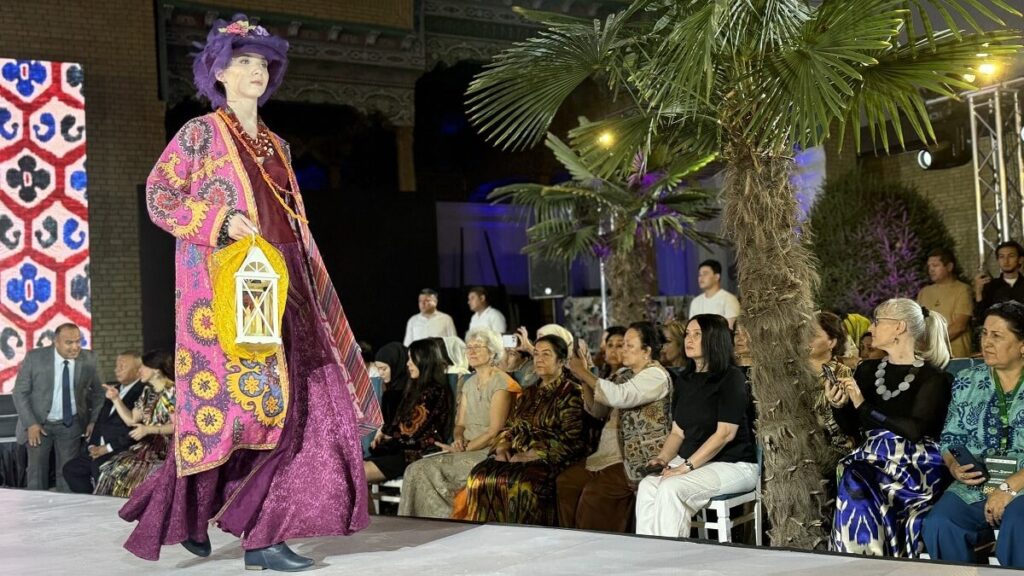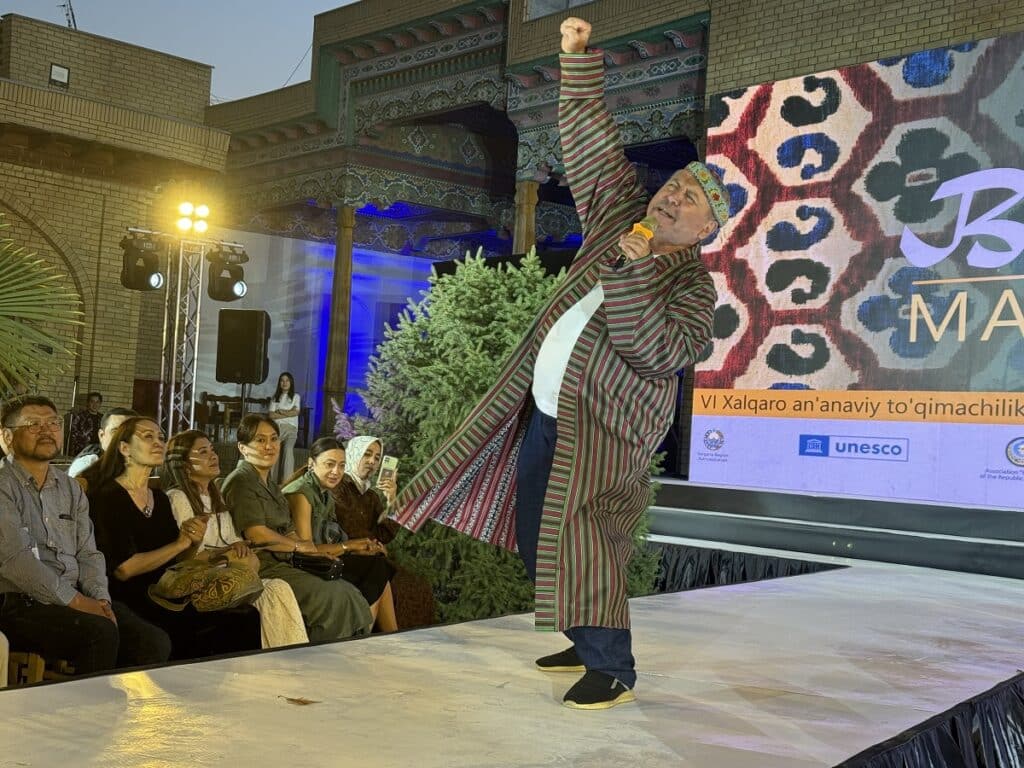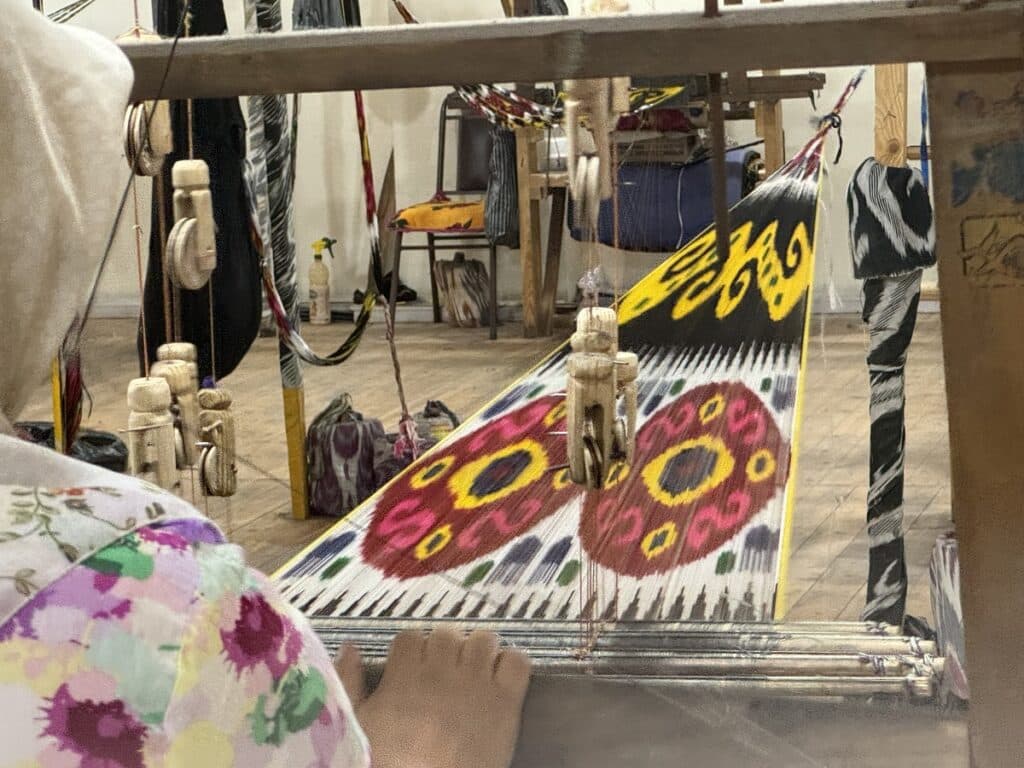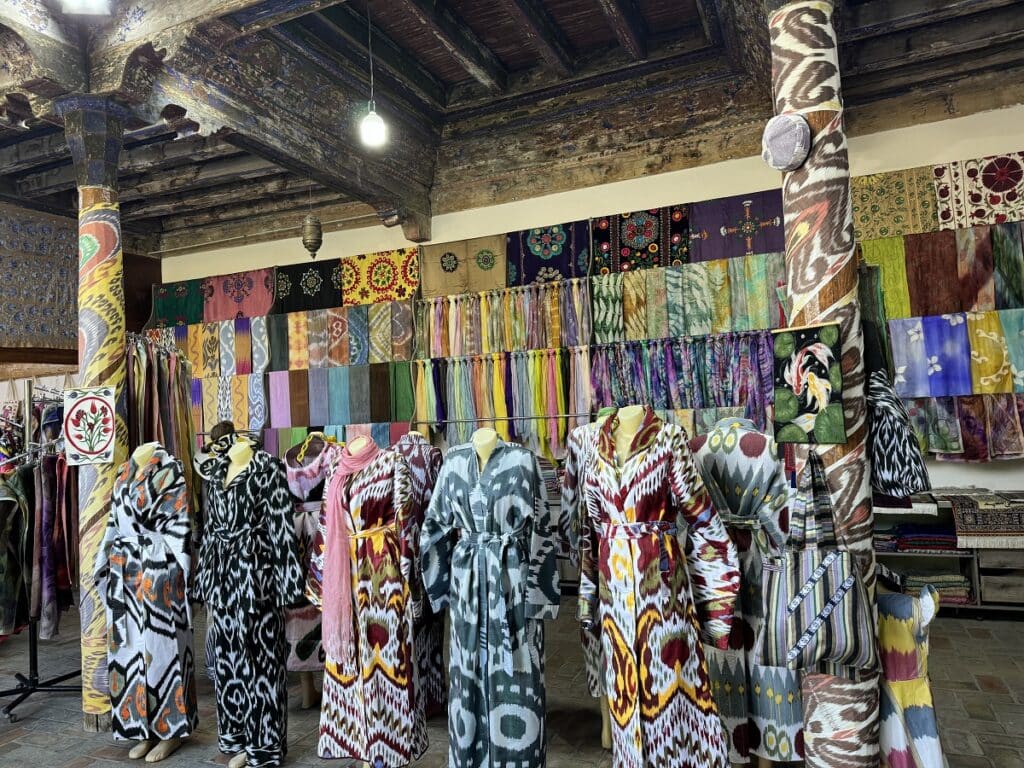
This is practically a rule in Uzbekistan: if your city has no ancient architectural masterpieces like those in Samarkand or Bukhara, you can still draw thousands of tourists from all over the world. All you need is to find something «unique» about your place and blow the trumpet of this.
Feel Brazilian vibes in Bukhara
In August 2021, when the COVID-19 pandemic was rampaging, Uzbekistan’s President Shavkat Mirziyoyev signed a decree on holding the Festival of Gold Embroidery and Jewelry. In the spring of 2022, as the world began to embrace breathing without face masks once again, the festival took place in Bukhara.
When asked why Uzbekistan needed the festival, Aziz Murtazaev, president of the World Crafts Council for the Asia-Pacific Region and advisor to the chair of the Hunarmand Association (Uzb. Craftsman), highlighted three key reasons, one of which was the development of Bukhara’s tourism potential.
«We hold festivals in all major cities,» he explained. «It’s like a carnival in Brazil, where hundreds of thousands of people come from all over the world to feel this atmosphere, enjoy the parade, and so on. We also organize parades, festive processions, and trade fairs, which immediately draw attention and become a feature that creates impressions and memories of the place.»
Registan Square in Samarkand, for example, hosts Sharq Taronalari (Melodies of the East), one of the largest music festivals in Central Asia. Similarly, Kokand brings together artisans from around the globe for the Hunarmand International Festival of Handcrafters.

The city of Namangan, just imagine, has been bursting with its flower festival since 1961. In 2019, the event gained international status, and in 2024 alone, it attracted over 200,000 tourists from 60 countries, according to the media outlet Plov.press.
Now, there are two festivals in Bukhara that go one after the other, occurring every two years. The Silk and Spices Festival brings back memories of the prime goods of the ancient Silk Road, while the Festival of Gold Embroidery and Jewelry celebrates traditional crafts of the historic city.
The museum town of Khiva hosts the «Lazgi» International Dance Festival and the Melon Festival.
Last but not least, the town of Margilan recently hosted the Sixth International Traditional Textile Festival, «Atlas Bayrami.» This experience demonstrates that our neighbors are on the right track: the more engaging events a country offers, the more tourists it attracts. Let’s take a closer look at this festival and the town.
The legend of silk and satin
Margilan serves as an example where the hook for tourists didn’t need to be invented. The ancient town has long been renowned for its silk, which legends claim is so exceptional that it could rival that of the Chinese.
Silk is an object of numerous legends, but two are the most popular.
The first one, which is a historical account, says that around two thousand years ago, a ruler of Fergana — an ancient state located in what is now modern-day Fergana, the capital of the region that includes Margilan — ordered his people to ferret out the secret of silk production from Chinese masters. When an Emperor of the Celestial Empire learned of this intention, he became furious and unleashed a war described in detail in Chinese chronicles.

However, there is another, more common version of the reason for the outbreak of conflict. It relates to Fergana’s fast and hardy horses, which Chinese warriors called «heavenly» and desired to obtain at any cost.
That being said, ancient Fergana defended its independence and successfully began producing silk. Locals have continued this tradition to the present day.
The second legend is a romantic story. Once upon a time, maybe also two thousand years ago, a strongman of Margilan fell in love with an artist’s daughter and decided to take her to his harem. The artist didn’t wish his beloved daughter this fate and, taking all his courage in both hands, demanded the khan to leave his daughter alone. . «Well,» the ruler smirked, «I might try to clear my mind of her beauty, but only if you create something as gorgeous before tomorrow morning comes.»

Filled with grief, the artist left the palace and sat at the brook bank. His mind raced, and he couldn’t focus on anything when suddenly clouds reflecting in the water caught his attention. It was a sunny day; the figures on the water glimmered with all the colors of the rainbow and fluttered with the breeze, gathering in an incredible pattern. Thanking the skies for inspiration, the artist rushed home and created a fabric as light as a cloud, refreshing as mountain air, soft and smooth. But the most essential part was its rainbow-coloring sheen.
When the ruler saw the cloth, he was astonished by its beauty. Although the girl eventually found herself in the khan’s palace, she was not one of the countless wives of the elderly ruler but rather the beloved spouse of his young son. The fabric was named «khan-satin» in honor of its origins.
Guides in the Fergana region tell both legends with great relish at the right moments, such as before entering the Yodgorlik silk factory.
In pursuit of good wine, cheese and silk
The idea of tourists visiting various factories isn’t new. In fact, there’s even a term for it: «industrial tourism.» This style of touring gained popularity in Europe in the late 1990s when experienced travelers grew tired of typical offerings such as city tours, museums, historical monuments and inevitable shopping. Soon, new experiences emerged: wine tours in France, cheese tours in the Netherlands, chocolate tours in Switzerland, distillery visits in Tennessee, and tea and silk factory tours in China. In almost all cases, the logical end of these tours is unfettered shopping in on-site shops. Indeed, how can anyone resist the temptation to buy a piece of chocolate made right before their eyes or wine that they just saw resting in large barrels in the cellar?
A similar experience awaits the tourists entering the Yodgorlik silk factory, which is entirely hand operated. The travelers are first shown the cocoons of silkworms, small fluffy balls, which unflappable Uzbek women spin right in front of the audience. Next comes the process of warping, where the main threads are wound simultaneously in a precise arrangement. It may sound boring, yet it’s a spectacular sight — the wooden loom spins like a merry-go-round. The threads are then wound onto two shafts and secured, with the specialist marking where knots will be tied. This is where the magic of creating the famous Uzbek abra or ikat cloth begins, as only the warp yarn is dyed during production. And finally tourists watch how the artist designs the patterns, and now it’s high time to remind them about the aforementioned legendary master, who created the first khan-satin.
Of course, when the excursion comes to an end, tourists can’t leave empty-handed. The exit conveniently leads through the gift shop, making it nearly impossible not to take home a piece of the legend, the vibrant atmosphere, and those glittering, flamboyant colors. At the very least, you’ll want a scarf — but perhaps even a vibrant chapan (a traditional Central Asian coat) or an entire piece of this magical cloth.
Excursions to the silk factories of Margilan are available year-round thanks to consistent demand as the Fergana region draws a big influx of tourists. The silk industry is not the only attraction; Margilan also hosts the Atlas Bayrami Silk and Satin Festival. During this vibrant event, the town fills with the loud sounds of the traditional Uzbek wind instrument, the karnay. Ladies parade with endless ribbons of abra fabric raised high above their heads, while designers from around the world showcase the beauty of khan-satin, bakhmal and bekasam on the catwalk. A bustling trade fair in the park adds to the excitement, where guests from Europe and the U.S. haggle over every thousand Uzbek sums (less than a cent) — mainly for fun to pay tribute to a local tradition rather than for profit.
Officials reported that Uzbekistan’s foreign tourist count reached 98% of the pre-pandemic level in summer 2024. In 2019, Uzbekistan welcomed 6.748 million foreign travelers; by 2023, the figure dropped to 6.626 million. It’s worth mentioning that the World of Statistics platform recognized Uzbekistan as one of the best countries to visit in 2024.
In Kazakhstan, it’s a common thing to explain the neighbor’s successes in tourism with medieval architecture monuments in Bukhara and Samarkand, while often neglecting the fact that Kazakhstan also has beautiful mausoleums of Khoja Ahmed Yasawi and the Kara-Khanid dynasty. However, Uzbekistan has proved that even a town lacking prominent ancient architecture can still attract tourists. The key is to invent or highlight one unique feature to market a site effectively. Although we may not have historical factories, we have preserved felt-making skills, one of the oldest crafts in the world. Just imagine how excited foreign tourists would be to witness the process of traditional felt production. In fact, in Kazakhstan, we even have a dance celebrating this craft.

